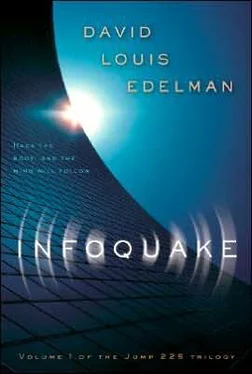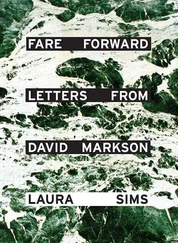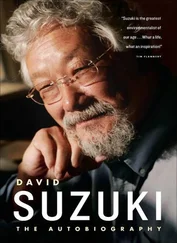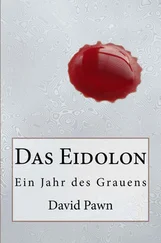"And what is my job?"
"You know exactly what your assignment is. You're to update the OCHRE software that monitors oculomotor signals to the third cranial nerve."
"But I know the third cranial nerve backwards and forwards!"
The neural programmer let out a heavy sigh and plucked at the white hairs sprouting from his chin. "I'm no fool," he said quietly. "I see that I'm not going to keep you here much longer under these conditions. Perhaps you're right. Let's get started in MindSpace tomorrow. But keep in mind that we are going to proceed very slowly."
* * *
Natch had spent plenty of time in the hive tooling around with bio/logic programming bars, but he had never coded anything of importance. One could only do so much testing among a group of upper-class hive children.
The 9971.6a software, by contrast, had a paying subscriber base of thirty million. Its logic fueled one of the molecule-sized OCHREs clinging to the cranial nerves. Natch's work here could conceivably affect the vision of an entire city the size of Omaha. To have such influence, such power ... he was nearly shivering with anticipation.
Natch stood at his workbench-a hand-me-down that Vigal had finally procured for him from a departing apprentice-and summoned a MindSpace bubble. The bubble was nothing more than a translucent shimmer, a void yearning to be filled. Natch called up 9971.6a. The diagram that appeared was a constellation of purplish blocks held together by thin strands of green.
It was obvious why Serr Vigal had slated this program for revision. Even someone as inexperienced as Natch could see that the code was several years out of date. Many of the green strands were looped around each other in a figure-eight formation that had been officially deprecated by Dr. Plugenpatch, and the program passed off information in a format that was incompatible with newer standards. But more than that, the program, for some indefinable reason, just looked wrong. Natch could practically feel it crying out in pain like an animal trapped in a thicket.
Natch reached for the satchel hanging off the side of the workbench and withdrew a plain metal rod from its sheath. Then he extended his arm into MindSpace and got to work.
Bio/logic programming bars looked like plain metal in ordinary space. Hollow tubes of silver labeled with Roman letters, the forearms of some mythical robot. But inside MindSpace, the bars blossomed into their true forms. Some looked like pincers, others pliers, others lariats or hammers or gloves. Each tool represented a specific logical operation that could be applied to a virtual structure. For instance, where a programmer of old might have written:
If color = blue Then ChangeEyeColor(blue)
Else If color = red Then ChangeEyeColor(red)
End If
-a bio/logic programmer could achieve the same effect by grabbing the red and blue strands in MindSpace and hooking them up to a ChangeEyeColor connector with a pincer-shaped programming bar.
Bio/logics was a science, but it was also an art form. One had to create the right number of connections in the right places. Too few connections would leave gaping holes in the program that could be exploited by malicious black coders; too many might produce unwanted side effects, or sap the body's computational system of precious resources.
Natch tore into the OCHRE software with the zealotry of the newly initiated. He completed his first round of modifications in three days, but spotted so many imperfections and inefficiencies along the way that he couldn't leave the program alone. Every connection he reassigned contained a logical flaw somewhere if he traced back far enough. And each of those flaws would lead to still other flaws.
For a week, Vigal left his apprentice to his own devices while he attended to other memecorp business. During that week, Natch barely ate or slept.
The neural programmer was completely unprepared for the sight that awaited him when he showed up the next week to inspect Natch's work. He was expecting to see a more polished version of 9971.6a, a purple constellation seen on a clear night. Instead, he saw a formation that might have come from another galaxy altogether. 9971.7 was arrayed in MindSpace with an almost military precision, each block tied to its fellows with a tight net of green strands. The offending figure-eights were nowhere to be seen.
"I suppose you were ready, after all," mumbled Serr Vigal, flabbergasted. "This is ... this is ..."
Natch stood in the opposite corner of the room with a grim smile on his face. This is extraordinary? This is exceptional? This is aweinspiring?
"This is-too much," stuttered Vigal.
Natch let out an explosive snort. "What do you mean, too much?"
The neural programmer turned as if he had just noticed his apprentice in the room. Twitching cheekbones bore evidence to the struggle going on in his head between the memecorp master and the parent. "Perhaps you are right," he said slowly, parental instincts in control. "I don't want to be critical, but at the same time ...
"You don't want me getting too far ahead of the other apprentices."
"Don't be a fool!" Vigal snapped with the tone of the memecorp master. "I was going to say, I want you to actually launch something while you are here in my apprenticeship."
Natch couldn't think of anything pertinent to say. In Vigal's countenance, the battle of responsibilities began anew, and he quickly found some excuse to sever his multi connection.
The next month was one of the most intense times in Natch's life. Vigal did not repeat his earlier criticism; instead, he encouraged Natch to submit 9971.7 to Dr. Plugenpatch at the earliest opportunity.
Plugenpatch approval was an absolute necessity to get the program listed on the bio/logics exchanges, and most OCHRE systems would refuse to obey any program that didn't carry at least a preliminary clearance from the public health agency. But just as importantly, the approval process provided an objective yardstick he could use to measure his progress. Vigal's motivations were transparent: he wanted to both get his point across and avoid confrontation.
Natch worked confidently towards Plugenpatch submission. He stood at his workbench for days on end, and the bio/logic programming bars just seemed to leap into his hands. The pain of the incomplete program was a visceral thing to Natch, a burning sensation that began in the tips of his toes and shot through his calves, sending his legs to pacing and his hands to searching for the cool balm of a bio/logic programming bar. But he was making progress. Little by little, he was liberating this mathematical beast from its confinement.
He finally submitted the program to Dr. Plugenpatch on a dry June afternoon.
The medical programming review system rejected it without comment.
Vigal took a cross-town tube over to Natch's flat that evening. He bore on his face the nervous look that foretold an approaching speech as surely as dark clouds foretold rain. Natch immediately started to lead his mentor towards his workbench, where 9971.7 hung in MindSpace. But Vigal called him back and had him sit down on the couch facing the living room viewscreen.
"Let us talk a little bit about change in a memecorp," he began slowly, eyes focused on the carpet. "Natch, no bio/logic program is an island. It has complex interdependencies, relationships to other programs." Vigal waved his hand at the viewscreen, causing it to broadcast a holographic blueprint of white, red and green squares that filled the room. Natch recognized this vast three-dimensional abacus on sight; it was the standard OCHRE engineering map of the human brain. Yet it represented only one small portion of the whole human programming schematic, which might have encompassed two or three square kilometers at this level of detail. "You will notice that these relationships are particularly dense in this area, the area of brainstem software." He pointed to a cluster of beads near the center of the diagram.
Читать дальше






![David Jagusson - Fesselspiele mit Meister David [Hardcore BDSM]](/books/486693/david-jagusson-fesselspiele-mit-meister-david-har-thumb.webp)





